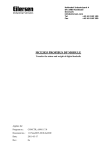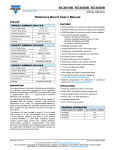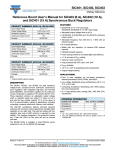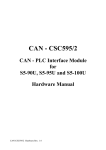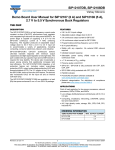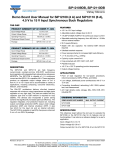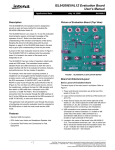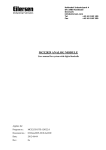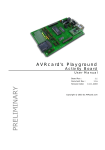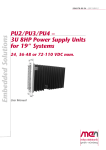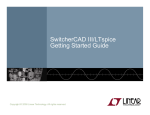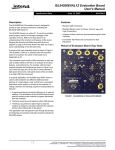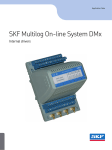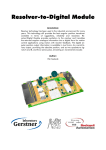Download SiP12116 Reference Board User Manual for SiP12116 (3 A)
Transcript
SiP12116 www.vishay.com Vishay Siliconix Reference Board User Manual for SiP12116 (3 A) FEATURES PRODUCT SUMMARY Input Voltage Range 3 V to 15 V Output Voltage range 0.6 V to 5.5 V Operating Frequency 600 kHz Continuous Output Current Package • 4.5 V to 15 V input voltage • Adjustable output voltage down to 0.6 V • 3 A continuous output current • Operational frequency 600 kHz 3A • 95 % peak efficiency DFN10 - 3 mm x 3 mm DESCRIPTION The SiP12116 is a high frequency current-mode constant-on-time (CM-COT) synchronous buck regulator with integrated high-side and low-side power MOSFETs. The SiP12116 is capable of 3 A continuous current. This regulator provides an adjustable output voltage which in standard setup can output 5 V down to 0.6 V to accommodate a variety of applications, including computing, consumer electronics, telecom, and industrial. The CM-COT architecture delivers ultra-fast transient response with minimum output capacitance and tight ripple regulation at very light load. The parts are stable with any capacitor type and no ESR network is required for loop stability. The regulator integrates a full protection feature set, it also has UVLO for the input rail and an internal soft-start. The SiP12116 is available in lead (Pb)-free power enhanced 3 mm x 3 mm DFN-10 package. SPECIFICATIONS This reference board allows the end user to evaluate the SiP12116 chip for its features and all functionalities. It can also be a reference design for a user's application. • Stable with any capacitor. No external ESR network required • Ultrafast transient response • Current mode constant on time • Power saving scheme for increased light load efficiency • ± 2 % accuracy of VOUT setting • Cycle-by-cycle current limit • Fully protected with OTP, SCP, UVP, OVP • PGOOD indicator • -40 °C to +125 °C operating junction temperature APPLICATIONS • Point of load regulation for low-power processors, network processors, DSPs, FPGAs, and ASICs • Low voltage, distributed power architectures with 5 V or 12 V rails • Computing, broadband, networking, LAN / WAN, optical, test, and measurement • A/V, high density cards, storage, DSL, STB, DVR, DTV, industrial PC CONNECTION AND SIGNAL / TEST POINTS Power Sockets ORDERING INFORMATION BOARD PART NUMBER MAX. OUTPUT CURRENT VOUT SiP12116DB 3.3 V 3A VIN, GND (P1): input voltage source with VIN to be positive. Connect to a voltage source: SiP12116 - 3 V to 15 V VOUT, GND (P2): output voltage with VOUT to be positive. Connect to a load that draws no more than: SiP12116 - 3 A SELECTION JUMPERS Enable P3: this needs a jumper in place to disable the part. When the jumper is removed the part will enable. It is advisable to apply VIN and then enable the part. SIGNALS AND TEST LEADS Input Voltage Sense VIN_SENSE, GNDIN_SENSE (P6): this allows the user to measure the voltage at the input of the regulator and remove any losses generated due to the, connections from the measurement. This can also be used by a power source with sense capability. Revision: 03-Sep-14 Document Number: 63419 1 For technical questions, contact: [email protected] THIS DOCUMENT IS SUBJECT TO CHANGE WITHOUT NOTICE. THE PRODUCTS DESCRIBED HEREIN AND THIS DOCUMENT ARE SUBJECT TO SPECIFIC DISCLAIMERS, SET FORTH AT www.vishay.com/doc?91000 SiP12116 www.vishay.com Output Voltage Sense VOUT_SENSE, GNDOUT_SENSE (P5): this allows the user to measure the voltage at the output of the regulator and remove any losses generated due to the connections, from the measurement. This can also be used by an active load with sense capability. Power Good Indication PGD (P4): is an open drain output and is pulled up with a 10 kΩ resistor to VIN. When VFB is within ± 50 % percent of the set voltage this pin will go HI to indicate the output is okay. POWER UP PROCEDURE To turn-on the reference board, apply 12 V to VIN with the P3 jumper is in position (this disables the part). To enable the part remove P3, a voltage can now be observed at the output. Note • Note: When applying higher than 12 V to the input it is reasonable to install a RC snubber from LX to GND. There are place holders on the reference board R7 and C10 for the snubber. Values of 10 Ω and 1 nF are a reasonable starting point. ADJUSTMENTS TO THE REFERENCE BOARD Output Voltage Adjustment If a different output voltage is needed, simply change the value of VOUT and solve for R3 based on the following formula: ( V OUT - V FB ) R3 = R4 x ----------------------------------V FB Where VFB is 0.6 V for the SiP12116. Output Ripple Voltage Output ripple voltage is measured with a tip and barrel measurement across COUT. Typically output ripple voltage is set to 3 % to 5 % of the output voltage, but an all ceramic output solution can bring output ripple voltage to a much lower level since the ESR of ceramics is very small. If ceramics or a combination of ceramics and bulk capacitors are used it may be necessary to add a voltage injection network. Inductor Selection The choice of inductor is specific to each application and quickly determined with the following equations: V OUT t on = ---------------------------------------V IN_MAX. × f SW ( V IN – V OUT ) × t on L = ----------------------------------------------I OUT_MAX. × k Where k is a percentage of maximum output inductor ripple current required. The designer can quickly make a choice if the ripple percentage is already decided based on the system design; it should be noted that the SiP12116 uses an internal current sense mechanism which translates as the voltage ripple component. The SiP12116 requires a Revision: 03-Sep-14 Vishay Siliconix reasonable ripple current, we recommend around 50 % as a start point. Other than the inductance the DCR and saturation current parameters are key values. The DCR causes an I2R loss which will decrease the system efficiency and generate heat. The saturation current has to be higher than the maximum output current plus 1/2 the ripple current. In over current condition the inductor current may be very high. All this needs to be considered when selecting the inductor. On this board Vishay IHLP series inductors are used to meet cost requirement and high efficiency, a part that utilizes a material that has incredible saturation levels compared to competing products. Output Capacitor Selection Voltage rating, ESR, transient response, overall PCB area and cost are requirements for selecting output capacitors. The types of capacitors and there general advantages and disadvantages are covered next. Electrolytic have high ESR, dry out over time so ripple current rating must be examined and have slower transient response, but are fairly inexpensive for the amount of overall capacitance. Tantalums can come in low ESR varieties and high capacitance value for its overall size, but they fail short when damaged and also have slower transient response. Ceramics have very low ESR, fast transient response and overall small size, but come in low capacitance values compared to the others above. A combination of technology is sensible. Enable Pin Voltage The ENL pin will need to be set to enable the part. This pin accepts an input voltage up to 5 V. On the reference design the pin has a voltage divider from VIN. There is also a jumper, P3, which shorts the pin to GND, this can be removed when a suitable voltage has been applied to VIN enabling the device. Bootstrap Circuit A bootstrap capacitor of 100 nF will be sufficient for this circuit with a switching frequency of 600 kHz. A series resistor has been added in order to slow down the low side switch and minimize overshoot without adding a snubber. This is user adjustable. This can be reduced to 0R to improve efficiency. VDD Decoupling The VDD pin will need to be decoupled in order to provide a stable voltage internally and externally. The value for this capacitor is recommended as ≥ 1 μF. Current Limit The current limit is set internally to 4.8 A. This will include the output current plus half of the ripple current. If the output current is greater than this value the current limit will be activated. Document Number: 63419 2 For technical questions, contact: [email protected] THIS DOCUMENT IS SUBJECT TO CHANGE WITHOUT NOTICE. THE PRODUCTS DESCRIBED HEREIN AND THIS DOCUMENT ARE SUBJECT TO SPECIFIC DISCLAIMERS, SET FORTH AT www.vishay.com/doc?91000 SiP12116 www.vishay.com Vishay Siliconix Output Capacitance The output capacitance will be determined by the ripple voltage requirement. Voltage mode COT topology can work with very small values of capacitor ESR however a ripple injection network will also be required for stable operation. 9 7 2 The overall capacitance needs to be calculated next. The following equations are used to calculate the size needed to meet a transient load response: 10 VIN I LPK = I OUT + 0.5 × I RIPPLE_MAX. LX 1 4 2 C OUT_MIN. L × ( I OUT + 0.5 × I RIPPLE_MAX. ) = -----------------------------------------------------------------------------------2 2 ( V PK ) - ( V OUT ) Where ILPK is the peak inductor current, IRIPPLE_MAX. is the maximum current ripple, IOUT is the maximum output current, and VPK is the output voltage plus the rise on load release. Input Capacitance In order to keep the design compact and minimize parasitic elements, ceramic capacitors will be chosen. The initial requirement for the input capacitance is decided by the maximum input voltage, 15 V in this case however a 35 V rated capacitor will be chosen of the X7R variety. In order to determine the minimum capacitance the input voltage ripple needs to be specified; VCINPP ≤ 150 mV is a suitable starting point. This magnitude is determined by the final application specification. The input current needs to be determined for the lowest operating input voltage: I OUT I CIN ( RMS ) = ------------ × V OUT × ( V IN - VOUT ) V IN The minimum input capacitance can then be found, DC- ( 1- DC ) C IN_MIN. = I OUT × ----------------------------------V CINPP × f SW Snubber Provision has been made for a snubber on the underside of the board which the user might need to consider populating if a higher input voltage is required. LAYOUT CONSIDERATIONS The SiP12116 offers the designer a compact buck regulator solution. If the below layout recommendations are followed, the same layout can be used to cover a wide range of output currents and voltages without any changes to the board design and only minor changes to the component values in the schematic. The reference design has a majority of the components placed on the top layer. This allows for easy assembly and straightforward layout. Figure 1 outlines the pointers for the layout considerations and the explanations follow. Revision: 03-Sep-14 6 0V 8 5 3 11 VOUT 5 Fig. 1 - Reference Design Pointers 1. Place input ceramic capacitors close to the voltage input pins with a small 10 nF/100 nF placed as close as the design rules will allow. This will help reduce the size of the input high frequency current loop and consequently reduce the high frequency ripple noise seen at the input and the LX node. 2. Place the setup and control passive devices logically around the IC with the intention of placing a quiet ground plane beneath them on a secondary layer. 3. It is advisable to use ceramic capacitors at the output to reduce impedance. Place these as close to the IC PGND and output voltage node as design will allow. Place a small 10 nF/100 nF ceramic capacitor closest to the IC and inductor loop. 4. The loop between LX, VOUT and the IC GND should be as compact as possible. This will lower series resistance and also make the current loop smaller enabling the high frequency response of the output capacitors to take effect. 5. The output impedance should be small when high current is required; use high current traces, multiple layers can be used with many vias if the design allows. 6. Use many vias when multiple layers are involved. This will have the effect of lowering the resistance between layers and reducing the via inductance of the PCB nets. 7. The quiet AGND should be connected to the PGND plane near to the input GND at one connection only of at least 1 mm width. 8. PGND can be used on internal layers if the resistance of the PCB is to be small; this will also help remove heat. Use extra vias if needed but be mindful to allow a path between the vias. 9. A quiet plane should be employed for the AGND, this is placed under the small signal passives. This can be placed on multiple layers if needed for heat removal. 10. The LX copper can also be used on multiple layers, use a number of vias. 11. The copper area beneath the inductor has been removed (on all layers) in this design to reduce the inductive coupling that occurs between the inductor and the GND trace. No other voltage planes should be placed under this area. Document Number: 63419 3 For technical questions, contact: [email protected] THIS DOCUMENT IS SUBJECT TO CHANGE WITHOUT NOTICE. THE PRODUCTS DESCRIBED HEREIN AND THIS DOCUMENT ARE SUBJECT TO SPECIFIC DISCLAIMERS, SET FORTH AT www.vishay.com/doc?91000 SiP12116 www.vishay.com Vishay Siliconix PCB LAYOUT Revision: 03-Sep-14 Fig. 2 - Top Layer Fig. 4 - Inner Layer 2 Fig. 3 - Inner Layer 1 Fig. 5 - Bottom Layer Document Number: 63419 4 For technical questions, contact: [email protected] THIS DOCUMENT IS SUBJECT TO CHANGE WITHOUT NOTICE. THE PRODUCTS DESCRIBED HEREIN AND THIS DOCUMENT ARE SUBJECT TO SPECIFIC DISCLAIMERS, SET FORTH AT www.vishay.com/doc?91000 SiP12116 www.vishay.com Vishay Siliconix Header 2 R4 1K OMIT 3.3μ C9 L1 100n VFB LX VCC C4 5V 2 PGD 10μ 10μ 10n C2 C1 Header 2 Revision: 03-Sep-14 Header 2 P6 1 2 Header 2 P3 1 2 0V P4 R1 4K53 1 2 0V Terminal P1 1 2 0V VIN C3 R5 1K 10K PGD9 R6 1μ LX EN 10 EN VIN 3 U1 GND GND GND 4 5 P1 SiP12116 BOOT 0V 6 1 VFB LX 7 8 BS R2 20R BS_1 C5 Terminal 22μ 22μ R3 4K53 10n C6 C7 VOUT C8 P2 1 2 P5 1 2 SCHEMATIC Document Number: 63419 5 For technical questions, contact: [email protected] THIS DOCUMENT IS SUBJECT TO CHANGE WITHOUT NOTICE. THE PRODUCTS DESCRIBED HEREIN AND THIS DOCUMENT ARE SUBJECT TO SPECIFIC DISCLAIMERS, SET FORTH AT www.vishay.com/doc?91000 SiP12116 www.vishay.com Vishay Siliconix BILL OF MATERIAL VIN = 12 V, VOUT = 3.3 V, fsw = 600 kHz ITEM QTY REFERENCE PCB FOOTPRINT VALUE VOLTAGE 1 2 C1, C2 1210 10 μF 35 V C1210C106M6PACTU KEMET 2 2 C3, C6 0402 10 nF 50 V GRM155R71H103KA88D MURATA 3 1 C4 0603 1 μF 10 V C0402C105M8PACTU KEMET 4 1 C5 0402 100 nF 35V CGA2B3X7R1V104K050BB VISHAY 5 2 C7, C8 0805 22 μF 10 V CL21A226MPQNNNE SAMSUNG 6 1 R2 0402 20 Ω - CRCW040220R0FKED VISHAY 7 1 R3 0402 4.53 kΩ - CRCW04024K53FKED VISHAY 8 1 R4 0402 1 kΩ - CRCW0402249KFKED VISHAY 9 1 L1 IHLP2525 3.3 μH - IHLP2020BZER3R3M01 VISHAY 10 1 U1 DFN10-3x3 - - SiP12116 VISHAY 11 1 R1 0402 4.53 kΩ - CRCW04024K53FKED VISHAY 12 1 R5 0402 1 kΩ - CRCW0402249KFKED VISHAY 13 1 R6 0402 10 kΩ - CRCW040210K0FKED VISHAY 14 4 P3, P4, P5, P6 HDR1x2 - - 90120-0126 MOLEX 15 2 P1, P2 TERM2 - - 282834-2 TE CONNECTIVITY PART NUMBER MANUFACTURER Note Only needed for reference board Revision: 03-Sep-14 Document Number: 63419 6 For technical questions, contact: [email protected] THIS DOCUMENT IS SUBJECT TO CHANGE WITHOUT NOTICE. THE PRODUCTS DESCRIBED HEREIN AND THIS DOCUMENT ARE SUBJECT TO SPECIFIC DISCLAIMERS, SET FORTH AT www.vishay.com/doc?91000






